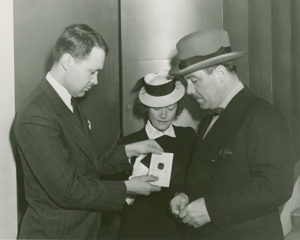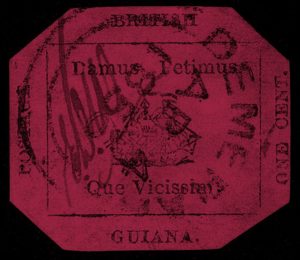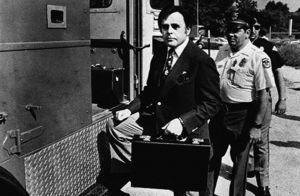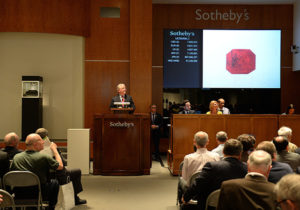By Dr. Odeen Ishmael
The 1856 one-cent “Black on Magenta” of British Guiana is regarded as the rarest stamp in the world, and the most expensive. It is a rectangular stamp of black ink printed on magenta paper with the corners snipped off. With the corners clipped off, the stamp actually has an octagonal shape.

(Photo courtesy of The New York Public Library, Astor, Lenox and Tilden Foundations)
In the nineteenth century, the stamps of British Guiana were printed by a British printer, Waterlow & Sons. In early 1856, the stock of stamps was sold out before the fresh shipment from England arrived. The postmaster of British Guiana E.T.E. Dalton, needed stamps in a hurry so he asked the firm of Joseph Baum and William Dallas, publishers of the Official Gazette in Georgetown, to print an emergency issue. Dalton printed one-cent and four-cent stamps; the one-cent stamps were for newspapers and the four-cent stamps were for letters. On these stamps were printed the existing designs “the name British Guiana, the seal of the colon” a ship, and the Latin motto of the colony, “Damus Petimus que Vicissim”, (translated as “We give and we seek in return”). Usually, stamps of different values of the same design were printed in different colours, but the printing firm did both values in black ink on coloured or “magenta” paper. Since the quality was very poor the postmaster, to prevent forgery, asked the post office workers to initial each stamp before selling it. Thus, as a security measure each stamp was initialled by a post office employee. (Known initials are “E.T.E.D.” for Dalton, “E.D.W” for Wight, “W.H.L.” for Lortimer and “C.A.W.”for Watson.)
In 1873, Vernon Vaughan, a 12-year-old Scottish schoolboy collector living in Georgetown, discovered the octagon-shaped one-cent “Black on Magenta”, postmarked April 4, 1856, among some family papers. It was in poor condition, ink-smudged and slightly damaged and bore the initials “E.D.W”. He soaked out the stamp and kept it in his album with his other stamps.

Shortly thereafter, Vaughn decided to sell it in order to purchase foreign stamps. He sold it to N. R. McKinnon, a local collector, for six shillings, which at that time was less than one US dollar. Five years later, McKinnon sold his entire collection to his friend Wylie Hill who lived in Glasgow, Scotland. Sometime later, a London stamp dealer, Edward Pemberton, studied the collection and identified the one-cent Black on Magenta as a rare stamp. Hill later sold it to Thomas Ridpath, a dealer in Liverpool, England, for 120 British pounds.
In the early 1900s this dealer then sold it to the Frenchman Count Philipp La Renotiere Von Ferrary, the most well-known stamp collector at that period, for 150 pounds. After Ferrari’s death in 1917, his collection was auctioned in Paris between 1921 and 1925. In one of these auctions, the stamp was purchased in 1922 by millionaire Arthur Hind of Utica, New York, for 7,343 British pounds. Around that time, rumours circulated that because Hind was obsessed with the stamp, he had bought a second one-cent Black on Magenta and destroyed it so that his remaining one- cent Black on Magenta would remain as the only one in the world.
Arthur Hind died in 1933 and left his stamp-collection as a part of his estate. His widow, however, claimed that the one-cent British Guiana stamp had been given to her by her husband. The court upheld her claim and in 1940 the stamp was sold to Frederick Small, an Australian living in Ft. Lauderdale, Florida, for a price ranging between US$40,000 to US$75,000.


In an auction held by Robert Siegel Galleries in 1970, the stamp was sold for US$240,000 to Irwin Weinberg and a group of investors from Wilkes Barre, Pennsylvania. The one-cent Black on Magenta remained in their collection for ten years when John E. du Pont of Philadelphia, Pennsylvania, bought it at an auction for US$935,000.
Meanwhile, the four-cent British Guiana magenta stamp, printed in the same batch in 1856, ranges in value from US$7,500 to US$60,000.
In 2014, the British Guiana One-Cent Black on Magenta set a new world auction record for any stamp at Sotheby’s New York, achieving US$9,480,000 – nearly 1 billion times its original face value. No stamp is rarer than the sole-surviving example of the British Guiana, a unique yet unassuming penny issue from 1856, which has been heralded as the pinnacle of stamp collecting for more than a century. Until Sotheby’s international exhibitions in Hong Kong, London and New York, the British Guiana had been out of public view since 1986. (“The Guyana Story – From Earliest Times to Independence” By Dr. Odeen Ishmael) (Guyana Times Sunday Magazine)



